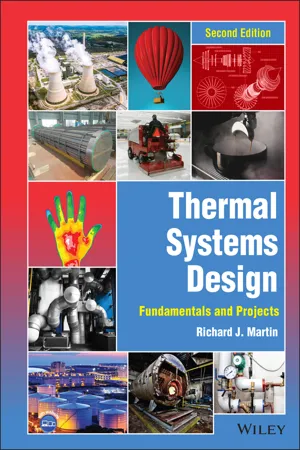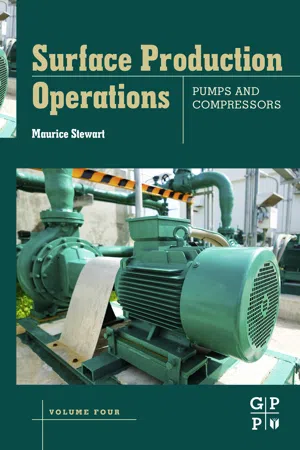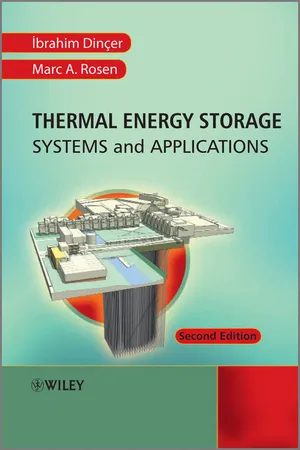Technology & Engineering
Polytropic Process
A polytropic process is a thermodynamic process in which the relationship between pressure and volume can be expressed as P*V^n = constant, where n is a constant. This type of process is commonly used to model the compression or expansion of gases in various engineering applications, such as in the operation of internal combustion engines and gas turbines.
Written by Perlego with AI-assistance
Related key terms
Related key terms
1 of 4
Related key terms
1 of 3
5 Key excerpts on "Polytropic Process"
- eBook - ePub
Thermal Systems Design
Fundamentals and Projects
- Richard J. Martin(Author)
- 2022(Publication Date)
- Wiley(Publisher)
As with any heat engine, the Carnot efficiency of a combustion turbine is governed by its maximum and minimum temperatures. However, with a Brayton cycle, the compressor power input is paid for out of the turbine power output, and the fuel consumed per unit of net shaft work goes down with higher pressure ratios, hence higher pressure ratios lead to higher cycle efficiencies.The overall pressure ratio for a large, multistage compressor/turbine combination can reach high levels (e.g.p 2 /p 1 > 50), but for microturbines and turbochargers, the overall pressure ratio is often much lower (e.g.p 2 /p 1 < 10). Consequently, the cycle efficiency of many smaller combustion turbines is typically quite low compared to those of large frame and aero‐derivative combustion turbines.9.3 Polytropic Processes
Recalling Chapters 5 and 6 , the following concepts are reiterated:- Lines host the various states of the working fluid in a thermodynamic cycle.
- Equipment executes processes to change the working fluid's state as it traverses through the cycle.
Subject to that terminology distinction, a unique equation can be constructed (Equations 9.1 ) that embodies at least four unique processes.(9.1a‐d)This formula, called the polytropic equation, is very useful for ideal gases, and it can be derived directly from the laws of mass, momentum, and energy conservation (with certain assumptions regarding irreversibilities and heat flows into or out of the control volume). The derivation is left to the student as a homework problem at the end of the chapter.Figure 9.3 shows the four processes on a pressure versus volume graph. The value forncould theoretically be any positive real number between zero and infinity, but the four processes described are unique and worthy of attention by themselves.Plots of four Polytropic Processes: isobar (constant pressure), isotherm (constant temperature), isentrope (constant entropy), and isochor (constant specific volume).Figure 9.3Source: Martin Thermal Engineering Inc.Then = 0andn - Maurice Stewart(Author)
- 2018(Publication Date)
- Gulf Professional Publishing(Publisher)
Compression theory is derived from the laws of thermodynamics. The theory is applicable to both positive displacement and continuous flow compressors.The two processes used to calculate thermodynamic relationships are isentropic (adiabatic) and polytropic. The Polytropic Process is a modification of the adiabatic process, involving an efficiency to more closely represent actual conditions. These calculations are the basis for determining capacity, driver size, and mechanical design. The following discussion explains the differences and when they are used.Fig. 7.12 shows the compression paths of three theoretical processes: isothermal, isentropic, and polytropic. The theoretical work needed for isothermal compression is described by the area ABEF. It can be seen that the isothermal work is appreciably less than that of the isentropic area ABDF. Similarly, the isentropic area is smaller than the polytropic area ABCF. Since the isothermal area is considerably less than the isentropic and polytropic it would be the process for greater compression economy.None of the three processes is commercially attainable; however, they are useful as a basis for calculations and comparisons.Fig. 7.12 Theoretical compression paths on P –V diagram for three different processes.The differences can be attributed to differences in heat transfer (cooling). The isothermal process would require continuous cooling during compression to negate the entire temperature rise. It is never commercially possible to remove the heat of compression as rapidly as it is generated. Thus, this process is not as logical a working base as the adiabatic although it was used for many years. Compressors are designed for as much heat removal as possible. In an actual compressor the theoretical isentropic discharge temperature can sometimes be achieved by a moderate amount of cooling during compression. Even so, the resultant process will not be purely isentropic due to other losses in an actual machine. The polytropic path BC best represents an actual process where there is no cooling during compression.- eBook - ePub
Thermal Energy Storage
Systems and Applications
- Ibrahim Dinçer, Marc A. Rosen(Authors)
- 2011(Publication Date)
- Wiley(Publisher)
Consider a closed system containing an ideal gas, undergoing an adiabatic reversible process. The gas has constant specific heats. The work can be derived from the first law of thermodynamics (FLT) as follows:(1.38)Equation 1.38 can also be derived from the general work relation, W = PdV .For a reversible Polytropic Process, the only difference is the polytropic exponent n which shows the deviation in a log P and log V diagram, leading to the slope. Equations 1.35 , 1.37 , and 1.38 can be rewritten with the polytropic exponent underPvn= constant as:(1.39)(1.40)(1.41)To provide a clear understanding of the polytropic exponent, it is important to show the values of n for four types of Polytropic Processes for ideal gases (Figure 1.5 ):- n = 0 for isobaric process (P = constant)
- n = 1 for isothermal process (T = constant)
- n = k for isentropic process (s = constant)
- n = ∞ for isochoric process (v = constant)
As can be seen in Figure 1.5 , there are two quadrants where n varies from zero to infinity and where it has a positive value. The slope of any curve is an important consideration when a reciprocating engine or compressor cycle is under consideration.In thermodynamics, a number of problems involve the mixture of pure substances (e.g., ideal gases). In this regard, it is important to understand related aspects accordingly. Tables 1.2 and 1.3 summarize the relevant expressions and two ideal-gas models: the Dalton model and the Amagat model. In the comparison presented, it is assumed that each gas is unaffected by the presence of other gases, and each is treated as an ideal gas. With respect to entropy, it is noted that an increase in entropy is dependent only upon the number of moles of ideal gases, and is independent of the chemical composition. Of course, when the gases in the mixture are distinguished, the entropy increases.1.4.15 Energy TransferEnergy can be viewed as the capacity for doing work. Energy can take a number of forms during transfer such as thermal (heat), mechanical (work), electrical, and chemical. Thermal energy flows only from a higher to a lower temperature level unless external energy is added to reverse the process. The rate of energy transfer per unit time is called power - eBook - ePub
- Tangellapalli Srinivas, N. Shankar Ganesh, R. Shankar(Authors)
- 2019(Publication Date)
- Apple Academic Press(Publisher)
The polytropic index plays an important role in this expression as it changes from 0 to ∞, facilitates any thermodynamic process in compression region and expansion region. This section relates the heat and work with polytropic index to understand the energy interactions in the process. We have that the work in Polytropic Process, W 1 − 2 = P 1 V 1 − P 2 V 2 n − 1 = m R (T 1 − T 2) n − 1 From first law of thermodynamics, Q = W + U 2 − U 1 After. simplification, Q = m R (T 1 − T 2) (n − 1) (γ − n γ − 1) (3.37) Q = W (γ − 1 γ − 1) Δ U = Q − W = W (γ − 1 γ − 1) − W = W ((γ − 1 γ − 1) − 1) = W (γ − n − γ + 1 γ − 1[--=PLGO-SEPARATO. R=--]) (3.38) Δ U = W (1 − n γ − 1) (3.39) (i) If n = 0 (constant pressure process), Q = W (γ /(γ − 1)), since γ > γ – 1, Q > W. The heat transfer is more than the work and the increment is equal to the change in internal energy. (ii) If n = 1, Q = W, it is possible with constant internal energy, that is, isothermal process. (iii) If n = γ, Q = 0, that is, it is an adiabatic process. (iv) At n = ∞ (constant volume process), since W = 0 and the second term is equal to infinity and Q ≠ 0. 3.19 Polytropic Process IN OPEN SYSTEM We know that, h = u + P v (3.40) d h = d u + P d v + v d P (3.41) From the first. law, d q = d u + P d v (3.42) d h = d q + v d P (3.43) Since the area under Ts diagram is heat similar to work which is the area under Pv diagram, d h = T d s + v d P (3.44) d q = T d s = d h − ν d P, it is the first law of thermodynamics applied to open system. In place of W, we can find − ν d P. Therefore, in an open system, w = ∫ − v d P (3.45) So the work in polytropic. process, w 1 − 2 = ∫ 1 2 − v d P = − ∫ 1 2 (C P) 1 / n d P ∴ P v n = C = − C 1 / n (P − (1 / n) + 1 − (1 / n) + 1) 1 2 = − C 1 / n (P 2 (n − 1) / n − P 1 (n − 1[--=PL - eBook - ePub
- Michael R. Lindeburg(Author)
- 2014(Publication Date)
- PPI, a Kaplan Company(Publisher)
k is the ratio of specific heats (see Eq. 14.17). Equation 14.12 and Eq. 14.13 are related by the ideal gas law.Equation 14.14 Through Eq. 14.17: Isentropic Process for Ideal Gases18.1418.1518.1618.17DescriptionEquation 14.14 through Eq. 14.16 are valid for ideal gases undergoing isentropic processes (i.e., entropy is constant). The ratio of specific heats , k , is given by Eq. 14.17. For closed, isentropic systems, Eq. 14.4 reduces to Eq. 14.12 and Eq. 14.13.ExampleAir is compressed isentropically in a piston-cylinder arrangement to 1/10 of its initial volume. The initial temperature is 35°C, and the ratio of specific heats is 1.4. What is most nearly the final temperature?(A) 350K(B) 360K(C) 620K(D) 770KSolution Since the process is isentropic, use Eq. 14.16 to calculate the final temperature. The answer is (D).Equation 14.18 and Eq. 14.19: Polytropic Process18.1818.19DescriptionA process is polytropic if it satisfies Eq. 14.18 for some real number n , known as the polytropic exponent . Polytropic Processes represent a larger class of processes. This is due to the fact that Eq. 14.18 reduces to other processes depending on the value of the polytropic exponent. Any process which is either constant-pressure, constant-temperature, constant-volume, or isentropic is also polytropic.n = 0 [constant pressure process] n = 1 [constant temperature process] n = k [isentropic process] n = ∞ [constant volume process] Processes with exponents other than 0, 1, k , and ∞ are typically found where the working fluid is acted upon by mechanical equipment (e.g., a reciprocating compressor). In a rotating device, the working fluid’s pressure, temperature, and volume are determined by what the machine does, not what would occur naturally.Example0.5 m3 of superheated steam at 400 kPa and 300°C is expanded behind a piston until the temperature is 210°C. The steam expands polytropically with a polytropic exponent of 1.3. The final volume and pressure of the steam are 0.884 m3
Index pages curate the most relevant extracts from our library of academic textbooks. They’ve been created using an in-house natural language model (NLM), each adding context and meaning to key research topics.
Explore more topic indexes
Explore more topic indexes
1 of 6
Explore more topic indexes
1 of 4




